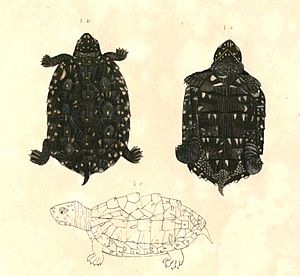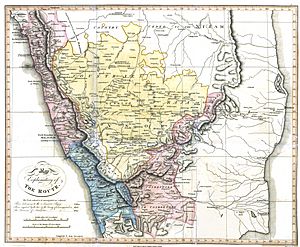Francis Buchanan-Hamilton facts for kids
Quick facts for kids
Francis Buchanan-Hamilton
|
|
|---|---|
| Born |
Francis Buchanan
15 February 1762 Callander, Perthshire
|
| Died | 15 June 1829 (aged 67) |
| Other names | Francis Hamilton, formerly Buchanan; Francis Hamilton; Buchanan-Hamilton; Francis Hamilton Buchanan; Francis Buchanan Hamilton |
| Education | University of Edinburgh |
| Known for | An account of the fishes found in the river Ganges and its branches |
| Awards | Fellow of the Royal Society of Edinburgh, Fellow of the Royal Society of London |
| Scientific career | |
| Institutions | Calcutta botanical garden, Royal Botanic Garden, Edinburgh |
| Influences | John Hope |
| Author abbrev. (botany) | Buch.-Ham. |
| Author abbrev. (zoology) | Hamilton, Hamilton-Buchanan |
Francis Buchanan (born February 15, 1762 – died June 15, 1829) was a Scottish surgeon, explorer, and botanist. He later changed his name to Francis Hamilton, but many people still call him Francis Buchanan-Hamilton. He made important discoveries about geography and animals while living in India. He only took the name Hamilton three years after he left India.
Contents
Early Life and Education
Francis Buchanan was born in Bardowie, near Callander, in Perthshire, Scotland. His mother, Elizabeth, lived on the Branziet estate. His father, Thomas, was a doctor.
Francis went to the University of Edinburgh in 1774 and earned his MA degree in 1779. Since he had three older brothers, he needed to choose a career to support himself. So, he studied medicine at the University of Edinburgh and became a doctor in 1783. His medical paper was about a type of fever called febris intermittens, which is now known as malaria.
After finishing his studies, Buchanan worked as a surgeon on Merchant Navy ships traveling to Asia. From 1794 to 1815, he worked for the Bengal Medical Service in India. He also studied botany (the study of plants) with a teacher named John Hope in Edinburgh. Hope was one of the first to teach the Linnean system of botanical nomenclature, which is a way of naming plants.
Career in India
Francis Buchanan's early career involved working on ships that traveled between England and Asia. He served as a surgeon on several ships. In 1794, he arrived in Calcutta, India, and joined the Medical Service of the British East India Company. He also helped manage a group that promoted the study of India's natural history.
Buchanan's skills as a surgeon and naturalist were perfect for a special trip to the Kingdom of Ava in Burma. He sailed on the Sea Horse and explored places like the Andaman Islands and Ava before returning to Calcutta.
In 1799, after a war in Mysore, Buchanan was asked to explore South India. He wrote a book about his travels called A Journey from Madras through the Countries of Mysore, Canara and Malabar (published in 1807). He also wrote An Account of the Kingdom of Nepal (published in 1819).
He carried out two big surveys. The first was in Mysore in 1800, and the second was in Bengal from 1807 to 1814. From 1803 to 1804, he was the surgeon for the governor general of India, Lord Wellesley, in Calcutta. While there, he helped set up a zoo that later became the Calcutta Alipore Zoo.
From 1807 to 1814, the government of Bengal asked him to do a complete survey of the areas controlled by the British East India Company. He had to report on many things, including:
- The land and its features (topography).
- The history and old buildings.
- How the people lived and their religions.
- Natural resources like fish, forests, and mines.
- Farming, including plants, tools, and animals.
- Arts and crafts.
- Trade, including what was bought and sold.
His findings were written in many detailed reports. These reports are still kept in major libraries in the United Kingdom. One very important work was about Indian fish species, called An account of the fishes found in the river Ganges and its branches (1822). In this book, he described over 100 types of fish that scientists had not known about before.
He also collected and described many new plants in the region. He gathered a collection of beautiful watercolor paintings of Indian and Nepalese plants and animals. These paintings were likely done by Indian artists and are now kept at the Linnean Society of London.
In 1806, he became a Fellow of the Royal Society, and in 1817, he became a Fellow of the Royal Society of Edinburgh. These are special honors for scientists.
Later Life
In 1814, Francis Buchanan took over from William Roxburgh as the superintendent of the Calcutta botanical garden. However, he had to return to Britain in 1815 because he was not well.
An interesting story from his life: the notes he took from his botany lectures in 1780 were lost by a friend in India. These notes ended up in the library of Tipu Sultan, a ruler in Mysore. In 1800, a major found them in Tipu's library and returned them to Buchanan.
When Buchanan left India in 1815, he inherited his mother's estate. Because of this, he took her family name, Hamilton. He then called himself "Francis Hamilton, formerly Buchanan" or just "Francis Hamilton." However, other people often referred to him as "Buchanan-Hamilton" or "Francis Hamilton Buchanan."
From 1814 until his death in 1829, he was the official Keeper of the Royal Botanic Garden, Edinburgh.
Animals Named in His Honor
Many animals have been named after Francis Buchanan-Hamilton to honor his work.
Reptiles

- The scientific name of a type of South Asian turtle, Geoclemys hamiltoni, honors Francis Buchanan-Hamilton.
Fish
- The fish Thryssa hamiltonii is one of the many fish named after Hamilton.
- The Burmese gobyeel Taenioides buchanani (named by Day in 1873) is named after him.
- Notropis buchanani (named by Meek in 1896).
- Psilorhynchus hamiltoni (named by Conway, Dittmer, Jezisek & H. H. Ng in 2013).
- The mullet Crenimugil buchanani (named by Bleeker in 1853).
- The mullet Sicamugil hamiltonii (named by Day in 1870).


